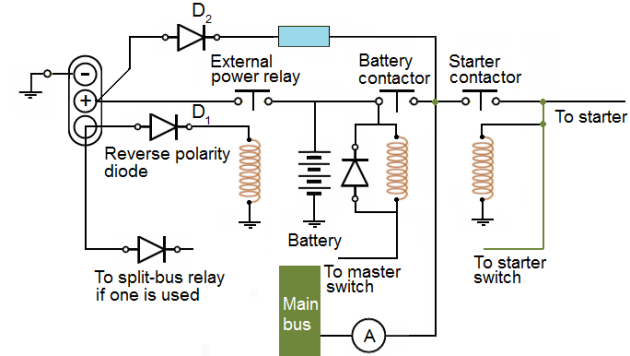DESCRIPTION AND OPERATION
Because of the heavy drain the starter puts on the battery, many aircraft are equipped with external power receptacles where a battery cart, or external power supply, may be plugged in to furnish power for engine starting.

Power is brought from a battery cart or rectifier through a standard three-terminal external power plug. Two of the pins in the aircraft receptacle are larger than the third, and are also longer. When the cart is plugged in, a solid contact is made with the two larger plugs. The external power relay in the aircraft remains open, and no current can flow fro the external source until the plug is forced all the way into the receptacle, and the smaller pin makes contact. This small pin then supplies power through a reverse-polarity diode to the external power relay that closes, connecting the external power source to the aircraft bus.
The reverse-polarity diode is used in the circuit to prevent an external power source with incorrect polarity from being connected to the aircraft's bus. The diode simply blocks current from flowing to the external power relay, if the applied power is connected backwards or is offering reverse polarity.
Depending on the system design, some external power sources can be connected to charge the aircraft battery, while others isolate the battery from the external power. For systems that provide for battery charging, it is quite possible that the aircraft battery can be so completely discharged that the battery contactor cannot get enough current to close. This would prevent the external power source from charging the battery.
To allow for battery charging, a circuit consisting of a diode, a current-limiting resistor and a fuse is connected between the positive terminal of the external power plug and the battery side of the battery contactor. With this arrangement, enough current can flow from the external power source to energize the battery contactor coil, so that it can close and allow the battery to be charged. A diode (D2) is in the circuit to prevent the positive pin in the external power receptacle from having power, or being "hot," when no external power plug is connected.
Today, with many of the smaller aircraft having 12-volt systems while others have 24-volt systems, it is extremely important to connect the correct voltage when using an external power source. Diode D1 prevents the external power relay closing if the power source has the wrong polarity, but there is normally no protection against improper voltage. Connecting the aircraft to the wrong voltage can severely damage sensitive electronic equipment.